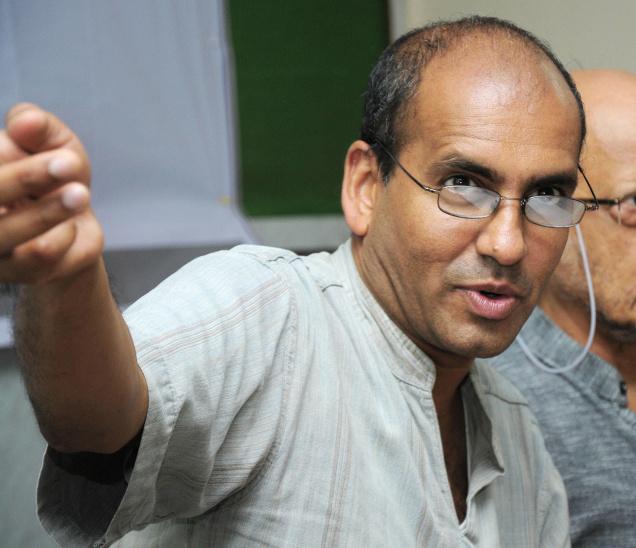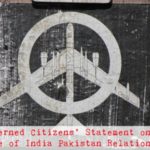What is the status of the nuclear arsenals of India and Pakistan? What dangers come from the postures and plans they have adopted? What influences do China and the United States wield in the region?
These and other topics were the subject of Dr. M. V. Ramana’s talk on ‘Nuclear Weapons in South Asia: Programmes, Plans and Dangers’ that was organised by Dr. Asghar Ali Engineer Memorial Advisory Committee and Coalition for Nuclear Disarmament and Peace (CNDP) on 27th August 2016 at Mumbai Marathi Patrakar Sangh. The talk was dedicated to the memory of Praful Bidwai, illustrious journalist, activist and social science researcher, who, among various other issues, worked tirelessly for nuclear disarmament and peace.

Dr. Ramana began by talking about how the early history of nuclear power in India, starting with the bill enabling the creation of an organization aimed at working on atomic energy introduced in the Constituent Assembly in 1948, barely a few months after independence, shows the importance given to nuclear power by the leaders of the country right from its inception as an independent nation. Although the purpose of the development of atomic energy was said to be for ‘peaceful purposes’, it was revealing that Pandit Jawarharlal Nehru, soon to be India’s first Prime Minister, had to concede that he did ‘not know how to distinguish the two (peaceful and defense purposes)’. The development of nuclear infrastructure by the Atomic Energy establishment took into account the possibility that the facilities constructed and expertise gained could be used for military purposes. In particular, the CIRUS reactor that started operating in 1960 and the Trombay reprocessing plant that was completed by 1964 allowed India to produce plutonium that could be used to make nuclear weapons.
Ramana then described the public debate about developing nuclear weapons that took place after the death of Nehru and the first Chinese nuclear weapon test in 1964. The debate revolved around questions of security, cost, morality, and prestige. Although it did not result in a decision to produce nuclear weapons, a series of developments eventually led to nuclear weapon test in 1974 in Pokharan, which was described as a peaceful nuclear explosion. The decision to conduct that test was reportedly taken soon after 1971 war with Pakistan and the creation of Bangladesh. Ramana pointed out that the decision to test was not taken in a moment of insecurity but in a moment of success (in breaking up Pakistan, India’s chief regional rival, into two countries). The timing of the test also undermines the argument of some who see China’s nuclear test as a cause for India’s weapons.
Although India did not follow the path taken by other nuclear weapon states and weaponise its nuclear design, the weapons program wasn’t inactive after the 1974 test. Instead, the nuclear establishment refined nuclear weapon designs and lobbied for more weapons tests. A missile programme was also set up that resulted in the design and production of the Prithvi and Agni missiles that could deliver nuclear weapons.
During the 1990s, increased activity by the bomb lobby, a group of people who advocated India developing nuclear weapons, succeeded in getting India to vote against the Comprehensive Test Ban Treaty. In parallel, the rise of Hindu nationalists and the Bharatiya Janata Party, with their militarist worldview, coming to power also created the conditions for the May 1998 nuclear tests. That involved five explosions on May 11 & 13, including that of a boosted/thermonuclear weapon (hydrogen bomb); there has been a recurring debate over whether that particular design was successfully tested.
Ramana also briefly described the trajectory of Pakistan’s nuclear programme, starting with the strategic relationship the country established with the United States, shortly after independence, in the context of the Cold War. Pakistani scientists were first trained by the United States as part of its Atoms for Peace programme. After the 1965 India-Pakistan war, where the United States did not aid Pakistan (whereas China did), some Pakistanis, in particular the US-educated Foreign Minister Z.A. Bhutto, called for a bomb. This call was to intensify after 1971 war that resulted in division of Pakistan and Bhutto launched nuclear weapon program in 1972, one month after taking office as President. After the 1974 Indian nuclear test, the US halted nuclear cooperation and A.Q. Khan, a metallurgist based in Holland, offered his services to help with the Pakistani nuclear programme, going on to set up the uranium enrichment programme. Revelation about this secret programme led the United States to impose sanctions on Pakistan, which was then reversed after the Soviets invaded Afghanistan in 1979 and the United States started using Pakistan as a staging ground to engage with the Soviets indirectly. The sanctions were re-imposed in 1989 only after the Soviets left Afghanistan. In the meanwhile, Pakistan had produced highly enriched uranium and developed bomb designs that were tested in May 1998. There were five explosions on May 28 and one on May 30, 1998. These were all of fission weapons and Pakistan did not conduct a thermonuclear weapon test.
In the aftermath of the 1998 nuclear tests, both India and Pakistan have been involved in the creation of doctrines and command structures to plan for the potential use of nuclear weapons. In India, the military has gained greater control of nuclear weapons. Peace talks between the countries have primarily been attempts at proving that India and Pakistan are responsible states and no substantial measure has been agreed upon.
As of 2014, the estimate of weapon-grade plutonium in India is around 600 kilograms. About 5 kg is sufficient for one nuclear weapon. The estimated stockpile of Highly Enriched Uranium (HEU) as of the end of 2014 in India is 3.2 ± 1.1 tons with a U-235 content of 1.0 ± 0.3 tons. This is said to be primarily for the nuclear (Arihant) submarine programme. However, because the estimated stockpile vastly exceeds what might be needed for all envisioned nuclear submarines, it is possible that the HEU might be used in nuclear weapons. About 25 kg is sufficient to produce one nuclear weapon. For Pakistan, the stockpiles are estimated to be 3.1 ± 0.4 tons of HEU and 190 kg of plutonium as of the end of 2014.
Both countries have tested numerous missiles and other delivery vehicles. India is in the process of developing two technologies that are profoundly destabilizing: Ballistic Missile Defense and Early warning systems. Ramana talked at some length about early warning, which involves setting up radars and satellites to detect the launch and flight of missiles. Although India has a ‘no first use’ policy, it is not clear how this commitment of no first use translates into actual deployment and action. In principle, this policy means waiting for an incoming missile to explode before retaliating. But setting up early warning systems suggests that the leadership does not envision waiting for such an explosion and might launch missiles as soon as there is warning of an impending attack; in other words, it would no longer be a strict no first use commitment.
Early warning technology has great potential for errors and accidental launches. Ramana provided examples from the Cold War era where U.S. leaders received false warnings that indicated Soviet nuclear missiles were approaching the United States when there was actually no such attack underway. One saving factor was that because they were so far apart, the United States and the Soviet Union had a longer time period to confirm missile launches; the travel time for a Soviet missile to reach the United States or vice versa is approximately 30 minutes due to the geographical distance between the two. But that is not the case in South Asia. India and Pakistan share boundaries and the time taken by a missile from one country to hit the capital city of the other would be only 6-13 minutes depending on where it was launched. Once you take away the time it takes to detect the launch and confirm that the missile is indeed directed towards the other country, there would be barely a couple of minutes for the Indian or Pakistani leadership to make a decision to respond. Because any technology is capable of errors and accidents, deploying an early warning system will increase the risk of inadvertent or accidental nuclear war.
Turning to a different aspect of nuclear weapons in south Asia, Ramana pointed out that the argument that nuclear weapons deter war failed within a year of the nuclear tests, when India and Pakistan had a military conflict over Kargil in Kashmir. The Kargil war was the first large scale military engagement between any two nuclear weapon states in the world. It involved a dozen or more nuclear threats by high-level officials in both countries, and there were reports that nuclear weapons were prepared for use on both sides.
The greater danger is in the longer-term, and this has to do with the lessons learnt by the Indian and Pakistani military establishments in the aftermath of Kargil. For Pakistan, the main lesson was that its nuclear arsenal prevented India from launching a massive attack, which India’s conventional military advantage could have allowed it to persecute. The strategy adopted in Kargil had earlier been presented to Benazir Bhutto in 1996, but she had rejected it then. For Indian military planners, the problem was that India would have to find ways of waging limited wars despite presence of Pakistani nuclear weapons. Similar lessons were also inferred by the two countries after the 2001-02 military crises that followed the attack on the Indian parliament.
There are news reports suggesting that in 2004, the Indian military adopted a strategy called Cold Start that would involve a “shift from defensive to offensive operations at the very outset of a conflict… not giving Pakistan any time to bring diplomatic leverages into play vis-à-vis India”. Pakistan’s response to this development has been to lower the threshold for use of nuclear weapons, with talk about developing ‘Battlefield Nuclear Weapons’ for use against incoming tanks. This game of lowering the threshold for the use of such catastrophic weapons is profoundly dangerous and destabilizing.
Lastly, Ramana mentioned the role of United States and the dangers of a four-way race that has intensified in recent years. U.S. relations with India changed radically during the Bush administration (2000-08). The Bush administration’s foreign policy was guided by neo-conservatives that saw the world in highly polarized terms. China was perceived as the chief barrier to U.S. supremacy and dominance in the international world order. Members of the Bush Administration, therefore, wanted to prop up India as a counterweight to China. As Condoleeza Rice, who went on to becoming Secretary of State, wrote in 2000: “India is an element in China’s calculation, and it should be in America’s, too. India is not a great power yet, but it has the potential to emerge as one.”
Under the 2004 Next Steps in Strategic Partnership, the United States agreed to help India with civilian nuclear activities, civilian space programs, dual-use high-technology trade and missile defense. In other words, India’s nuclear weapons ceased to be seen as something to be concerned about, and instead became seen as a necessity to keep China off balance. This policy has continued even in the Obama administration, which signed a Joint Strategic Vision for the Asia-Pacific and Indian Ocean Region. An important clause in the vision was the joint affirmation of “the importance of safeguarding maritime security and ensuring freedom of navigation and over flight throughout the region, especially in the South China Sea”. U.S. support for India’s NSG (Nuclear Suppliers Group) membership should be seen in this light.
There are two questions relevant to the NSG discussion. What does India gain by becoming a NSG member?According to Ramana, India has nothing to gain in material terms since it already had access to nuclear reactors and uranium. The only possible benefit is purely symbolic – being able to sit at the high table with the big boys. But what does India have to lose or pay to join NSG? According to Ramana, the stakes are quite clear – it is part of the United States’ ploy to get India on to their side against China in multiple spheres – diplomacy, NSG and even possibly the Security Council. The question that Ramana says we need to ask ourselves is – is this the role India should be playing? Is this competition with China desirable?
Ramana concluded by pointing out that there’s essentially a four-way race happening between India-Pakistan-China-United States. Pakistan seeks military and economic help from China and United States to balance India. India seeks support from United States to further its great power ambitions. China is trying to establish itself as an emerging global power able to re-order the international system. The United States is trying to limit its decline as the dominant world power by constraining and balancing the rise of Chinese power and influence. The dangers of this military and nuclear race and the build-up of nuclear weapons are extremely worrisome. Also of concern is the fact that all of this is happening out of sight and is therefore out of the minds of the general public.
The session was chaired by Anand Patwardhan and Darryl D’Monte represented the Dr. Asghar Ali Engineer Memorial Advisory Committee on the dais. The audience consisted of students from various institutes, people who are engaged in struggles in Jaitapur and nuclear issues, professors and researchers. The question and answer session that followed the talk was wide-ranging, involving discussions about topics as varied as the relationship between deterrence and terrorism, and the ethical quandaries associated with the production of radioactive waste that is hazardous for centuries.
written by
Pratiksha Nair
Programme Coordinator, CSSS


